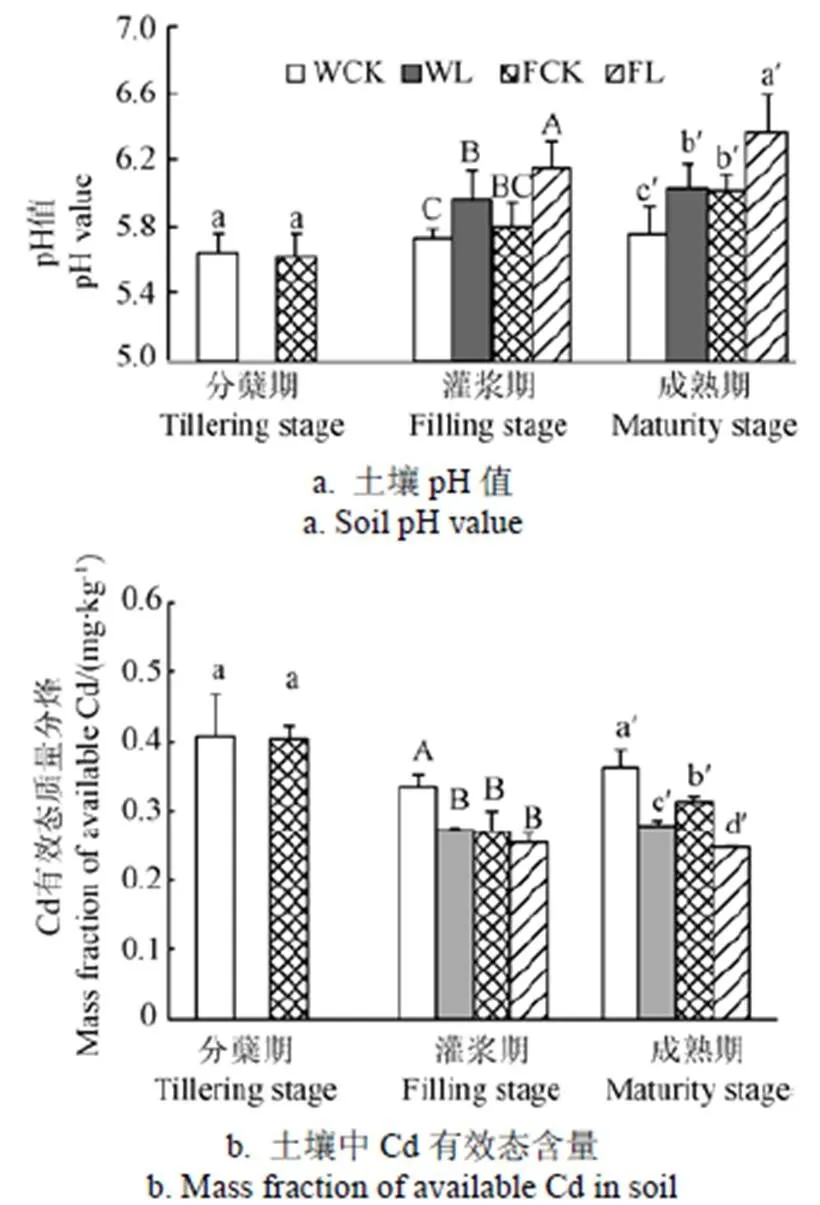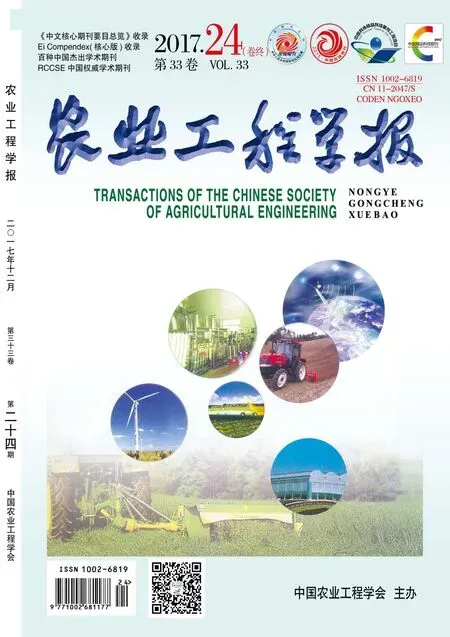水分管理和施用石灰对水稻镉吸收与运移的影响
史 磊,郭朝晖,梁 芳,彭 驰,肖细元,封文利
水分管理和施用石灰对水稻镉吸收与运移的影响
史 磊,郭朝晖※,梁 芳,彭 驰,肖细元,封文利
(中南大学冶金与环境学院,长沙 410083)
通过田间试验,研究了间歇灌溉和全生育期淹水2种水分管理结合水稻分蘖期施用石灰对不同水稻生育期的土壤和水稻各组织中Cd分布与运移的影响。研究结果表明,全生育淹水和施用石灰均能升高土壤pH值,降低土壤中有效态Cd含量;施用石灰能降低土壤中酸可提取态Cd所占比例而残渣态所占比例增加。在全生育期淹水条件下施用石灰有利于改善土壤性状并提高土壤中Fe质量百分含量。与不施用石灰相比,在间歇灌溉条件下,施用石灰处理的糙米中Cd质量分数从0.86 mg/kg降低到0.56 mg/kg,而在全生育期淹水条件下,施用石灰处理的糙米中Cd质量分数从0.77 mg/kg降低到0.34 mg/kg;无论间歇灌溉还是全淹水处理条件下,施用石灰均增加了水稻总生物量。施用石灰后,在灌浆期,水稻茎叶中Cd的富集系数显著降低(<0.05);在成熟期,根和稻米中Cd的富集系数显著降低(<0.05);在全生育期淹水条件下,成熟期水稻根到茎叶转运系数和茎叶到米中转运系数均显著降低(<0.05)。水稻糙米中Cd含量与土壤中有效态Cd含量、水稻地上部Cd累积量呈显著正相关,与土壤pH值呈显著负相关。上述研究结果表明,施用石灰能够显著降低稻田土壤中Cd的生物有效性;采用全生育期淹水结合在分蘖期施用石灰是降低稻米中Cd含量有效措施且不会导致水稻减产。
水分管理;石灰;重金属;水稻;镉;富集系数;转运系数
0 引 言
农田土壤Cd污染会给农产品安全和人体健康带来潜在的危害[1]。水稻是中国的主要农作物之一,中国部分地区稻田土壤中Cd污染问题突出,发展适宜的修复技术降低水稻对土壤中Cd的吸收是目前研究的热点之一[2-5]。石灰是一种廉价易得的化学改良剂,常用于治理受重金属污染的土壤。Simón等[6]报道在酸性农田土壤中施用石灰能够提高土壤pH值,从而有利于Cd的沉淀。在黄铁矿矿区污染土壤中施用石灰与植物修复技术联合修复土壤也能达到较好的效果[7]。Hale和Bolan等[8-9]均报道了添加石灰能够降低土壤中Cd迁移性。事实上施用石灰降低土壤中重金属的有效性与土壤类型和水分管理等因素密切相关[10-11]。在水稻种植过程中,通过水分管理也能够降低土壤中Cd的生物有效性[12-13]。张雪霞等[14]通过盆栽试验发现,水稻植株中Cd含量随着土壤水分含量的增加而减少。Chen等[15]报道在淹水条件下,施用石灰能够明显降低土壤中Cd生物有效性。Arao等[16]报道在水稻抽穗后淹水能够明显减少稻米中Cd浓度。Hu等[17]报道在水稻不同生育期全淹水和间歇灌溉能够提高水稻稻米的产量,且降低水稻各器官Cd浓度同时发现生殖生长期在控制水稻茎叶和根系中Cd积累比营养生长期起着更重要的作用。然而,上述研究结果多是通过盆栽试验所得,在实际生产中水稻生长大都是一个间歇灌溉的过程。通过间歇灌溉和全生育期淹水2种水分管理措施与石灰联用对农田土壤中Cd的有效性及水稻对镉的吸收与运移的影响等较少报道。
本文通过大田试验,在间歇灌溉和全生育期淹水2种水分管理措施与石灰施用组合条件下,研究水稻不同生育期土壤pH值、Cd在土壤中生物有效性以及在水稻植株各器官中累积和运移特征;评估间歇灌溉和全淹水与石灰组合施用对Cd在水稻中累积和运移的影响。为中国南方Cd污染稻田土壤治理过程中实现边修复边生产同时又避免稻米减产提供一定技术支撑。
1 材料与方法
1.1 供试土壤和水稻
供试田间试验点位于湖南省湘潭市郊区某Cd污染稻田。供试稻田土壤基本理化性质见表1。供试水稻品种为五丰优569()。田间试验用石灰为市售商品,其中总Cd质量分数为0.47 mg/kg。

表1 供试土壤基本理化性质
1.2 试验设计
田间试验按照全生育期淹水和间歇灌溉2种水分管理模式,以及分别施用石灰进行设计,共4个处理。即1)间歇灌溉(WCK):田间灌水后保持3~5 cm表水层直到水稻分蘖后期落干1次,在灌浆结实期进行2次“淹水-落干”,田间土壤落干5~7 d达到田面有微裂痕迹,即土壤含水率在70%~90%,呈“湿硬”状态[18];2)间歇灌溉+石灰(WL);3)全生育期淹水(FCK):全生育期淹水为在整个生育期保持3~5 cm田间表水层;4)全生育期淹水+石灰(FL)。每处理3个重复,共12个试验小区。每个试验小区面积为5 m×7 m,随机排列。试验小区周边设保护行,小区间田埂用塑料薄膜覆盖,防止小区间窜水。基肥组成N∶P2O5∶K2O=1∶0.5∶1,以尿素、磷酸二氢钾和氯化钾形式加入,稳定7 d后于2015年7月20日移栽秧苗,水稻行距为10 cm×15 cm。分别在水稻种植至分蘖期(8月18日)、灌浆期(10月13日)和成熟期(11月10日)采集水稻和土壤样品。在分蘖期采集样品后第2天(8月19日)施石灰到表层土壤中,石灰用量1 500 kg/hm2。其他施肥(追肥)、病虫害防治等管理措施均按当地居民习惯进行。
1.3 样品收集与分析
采集水稻根区土壤样品,在室温下自然风干,剔除土壤中杂物,将土壤碾碎,充分混匀后,分别过20目和100目筛后保存至封口塑料袋中备用。水稻样品带回实验室先用自来水冲洗,再用去离子水冲洗干净,将鲜样分为根、茎叶和籽粒装纸袋,105 ℃杀青1 h后,再于60 ℃烘至恒质量,称其质量后,粉碎装入自封口塑料袋中备用。
土壤pH值采用1∶2.5水土比浸提,pH计(雷磁,PHS-3C)测定。土壤有机质含量采用重铬酸钾容量法测定;碱解氮采用碱解扩散法测定;有效磷采用碳酸氢钠提取-钒钼黄比色法测定;速效钾采用醋酸铵-火焰光度计法测定;土壤中有效态Cd含量采用《土壤质量有效态铅和镉的测定原子吸收法GB/T 23739-2009》测定;土壤中Cd的赋存形态采用改进的BCR法提取[19]。土壤样品用HF-HNO3-HClO4法消解,水稻植株和糙米样品采用HNO3-HClO4法消解,消解液中Cd含量采用ICP-MS(美国,Thermo FisherX2)测定。土壤颗粒表面形貌及能谱采用扫描电子显微镜(日本,JSM-6360)进行扫描分析。
1.4 数据处理
水稻中Cd的生物富集系数[20]和转运系数[21]按照如下公式进行计算:
BCF=M/soil(1)
TFrs=shoot/root;TFsbr=rice/shoot(2)
式中M分别代表水稻根系、茎叶和稻米中Cd质量分数,mg/kg;soil为土壤中Cd质量分数,mg/kg;shoot为水稻茎叶中Cd质量分数,mg/kg;rice糙米中Cd质量分数,mg/kg。
所有试验数据采用Microsoft Excel 2010进行分析处理。采用SPSS 18.0 统计软件进行单因素方差分析(One-way ANOVA)比较各处理间的差异,显著性水平为<0.05。
2 结果与讨论
2.1 土壤pH值及有效态Cd含量变化
水分管理和施用石灰能够影响土壤pH值和土壤中有效态Cd含量。从图1a可知,未施石灰处理下,整个水稻生育期内,间歇灌溉(WCK)处理下,土壤pH值无明显变化;与WCK相比,全淹水(FCK)处理条件下,土壤pH值从分蘖期5.7升高到成熟期6.0。在全生育期淹水和间歇灌溉条件下,在稻田土壤中施用石灰,均能显著增加土壤pH值。从图1a中可以进一步可知,在水稻生殖生长期土壤pH值均得到不同程度的升高,而在这一生育期对水稻吸收Cd有较大影响[9]。

注:同一生育期不同字母表示具有显著差异(P<0.05)。WCK、WL、FCK和FL分别表示间歇灌溉、间歇灌溉+石灰、全淹水和全淹水+石灰,下同。
水分管理使土壤中Cd有效态含量呈降低趋势(图1b)。随着水稻生长,WCK处理与其他处理相比,在水稻各生育期土壤中有效态Cd含量均较高,其原因可能是在落干过程中形成的氧化环境有利于土壤中有效态Cd含量升高[16]。除分蘖期外,和WCK处理相比,FCK处理下土壤有效态Cd含量均呈降低趋势,其原因可能是FCK条件下土壤形成的还原环境,使Cd2+通过还原作用取代FeS中的Fe元素生成CdS沉淀,降低土壤中Cd的有效性[22]。施用石灰后土壤中有效态Cd含量均有不同程度的降低。和WCK相比,WL处理分别使水稻灌浆期和成熟期土壤有效态Cd含量分别显著降低20.6%(<0.05)和22.2%(<0.05);和FCK相比,FL处理灌浆期土壤有效态Cd含量变化不明显,使成熟期土壤有效态Cd含量显著降低22.5%(<0.05)。有文献报道施用石灰能增加土壤pH值和土壤颗粒表面负电荷数,增强对Cd2+的吸附,为Cd2+的氢氧化物或碳酸盐沉淀的形成提供了便利条件[9,23]。
2.2 土壤Cd形态的变化
土壤样品中Cd形态分析采用改进的欧共体标准物质局提出的BCR连续提取法。与WCK相比,FCK处理能降低土壤中Cd有效性,其中在成熟期降低程度最大,可使酸可提取态Cd所占比例降低44.4%,可还原态和可氧化态所占比例分别增加56%和75%(图2)。与Arao等报道的土壤淹水处理能够促进酸可提取态Cd转换为可还原态Cd和可氧化态Cd的结果相一致[16]。施用石灰后,能够进一步降低土壤中酸可提取态Cd所占比例,增加可还原态、可氧化态及残渣态所占比例;和灌浆期相比,成熟期土壤中Cd酸可提取态所占比例降低幅度较大。在成熟期,和WCK相比,WL处理使Cd酸可提取态所占比例降低11.8%,相应的残渣态比例增加15%;和FCK相比,FL处理下土壤中Cd的酸可提取态比例降低8.9%,而Cd的还原态和可氧化态和残渣态分别增加60%、78%和18%。表明田间水分管理结合石灰施用可促进土壤中有效态Cd向无效态的转化。Bolan和Guo等也报道施用石灰将会降低土壤中有效态Cd和提高土壤中残渣态Cd的结果[9,24]。

图2 不同生育期土壤中Cd形态所占比例
2.3 水稻土壤表面形貌及其化学组成
水稻成熟期土壤颗粒的SEM/EDS分析结果如图3所示。在WCK处理下,土壤颗粒较大且表面出现明显絮状物;在FCK处理下土壤颗粒较小,表面较光滑(图3a,3c),且土壤颗粒间排列较致密,其可能会降低土壤通透性,影响农作物的生长。施用石灰处理,土壤表面出现较少絮状物且在较大土壤颗粒表面附着细小光滑颗粒(图3b、3d),其中在FL处理下土壤中细小光滑颗粒数量明显多于WL处理。

注:图中方框代表能谱扫描位点。 Note: Box in the figures is the EDS scanning point.
土壤颗粒表面的光滑颗粒形成可能是淹水处理下土壤溶液中土壤胶体沉积到土壤基质表面所致。此外,施用石灰会增加土壤中的Ca2+,进而促进土壤中矿物(如铁矿物)表面胶体的形成[25]。土壤中胶体的增多会增强对土壤中Cd的吸附。通过EDS结果可知,FCK处理下土壤中Fe的质量分数高于WCK处理。张雪霞等[14]也报道全淹水条件下能适当增加土壤中Fe含量。有研究表明土壤中Fe含量与有效态Cd含量呈负相关[26]。施用石灰后,土壤中Fe的质量百分比有所降低,其原因可能是土壤中阳离子增多与其竞争吸附位点,导致土壤中Fe沉积在水稻根表面形成根表铁膜,具体过程有待进一步研究。
2.4 水分管理对石灰调控水稻吸收Cd的影响
2.4.1 不同生育期水稻生物量
由表2可知,和FCK相比,WCK处理能增加水稻生物量,其原因可能是在稻田落干的过程中,增加了根系活力,促使了叶片光合作用,其有利于水稻生物量的增加。与Muehe等[27]和Won等[28]发现在种植水稻过程中间歇灌溉能够提高水稻产量的结果一致。在WCK和FCK条件下施用石灰,对水稻各生育期生物量影响不同,在灌浆期,除淹水条件下施用石灰使根部生物量降低外,其他水稻各部位生物量均呈增加趋势;在成熟期,水稻各部位生物量总体上呈降低趋势,但稻米产量均增加10%左右。表明田间水分管理结合石灰施用有利于水稻生物量的增加。

表2 不同处理及生育期水稻生物量的影响
注:同一列中不同字母表示不同水平处理间存在显著差异(<0.05),下同。
Note: Different letters in same row indicate significant difference in different treatment (<0.05), the same as below.
2.4.2 不同生育期水稻各器官中Cd的含量和累积量
在水稻各生育期内,WCK与FCK处理水稻各器官中Cd含量差异不显著(表3),与先前已有报道在全生育期淹水条件下处理能降低植物中Cd含量[29-30]结论不一致。两种水分管理条件下,施用石灰后,在灌浆期水稻根部的Cd含量显著降低(<0.05),在成熟期水稻茎叶Cd含量显著降低(<0.05)。和WCK相比,WL处理下糙米中Cd质量分数从0.86 mg/kg降低到0.56 mg/kg;和FCK相比,FL处理下糙米中Cd质量分数从0.77 mg/kg降低到0.36 mg/kg。表明全生育期淹水并施用石灰,对降低糙米中Cd含量的协同作用更明显。

表3 不同生育期水稻各器官中Cd的含量
表4是4种处理对不同生育期水稻地上部和地下部Cd累积量的影响。和WCK相比,FCK处理下,在灌浆期显著降低水稻地下部和地上部Cd累积量(<0.05)。和不施用石灰相比,施用石灰后在各生育期水稻地上部和地下部Cd的累积量均降低。其中在灌浆期水稻地下部Cd累积量显著降低(<0.05);在成熟期,水稻地上部和地下部Cd累积量均显著降低(<0.05)。

表4 不同生育期水稻地下部与地上部Cd累积量的变化
2.4.3 水稻对Cd的转运和富集特征
采用生物富集系数(BCF)可以评价水稻各器官对土壤重金属的吸收情况[31]。由表5可知,4种处理条件下,水稻各器官生物富集系数均随着水稻生长而升高。在水稻各生育期中,FCK处理下BCF值略低于WCK处理。在水稻灌浆期,和WCK相比,WL处理下茎叶富集系数(BCFfs)显著降低;和FCK相比,FL处理下根部富集系数(BCFfr)和茎叶富集系数(BCFfs)均显著降低。在水稻成熟期,WCK和FCK条件下,施用石灰均显著降低根部富集系数(BCFmr)和糙米富集系数(BCFmbr)。
转运系数(TF)指植物后一部位中Cd 含量与前一部位中Cd 含量的比值,转运系数越大,则表明该部位对Cd 的转运能力越强[32-33]。TFmsbr代表茎叶到糙米中Cd的转运系数。4种处理对根系到茎叶中Cd的转运系数和茎叶到糙米中转运系数(TFmsbr)均小于1。这说明尽管水稻根系富集大量Cd,但是,仅有一少部分的Cd通过根系转运到了茎叶中。根系是阻碍Cd的天然屏障,在根系表面形成的根表铁膜是抑制土壤中Cd转运的关键[11]。从分蘖期到成熟期根到茎叶的转运系数逐渐升高。但是和WCK相比,FCK处理在一定程度上能降低转运系数和TFmsbr。在WCK和FCK两种条件下,施用石灰均能够降低在水稻各生育期的转运系数和TFmsbr,其中在成熟期,和FCK相比,FL处理使水稻TFmrs和TFmsbr分别显著降低34.5%和33.3%(<0.05)。上述结果说明,全生育期淹水处理在水稻各生育期能降低水稻中Cd的TF和BCF。在全生育期淹水和间歇灌溉2种水分管理条件下,施用石灰是显著降低Cd在水稻中转运系数和富集系数的重要措施。

表5 不同生育期水稻根、茎叶和稻米中Cd的富集系数和转运系数
注:BCFtr和BCFts分别为水稻分蘖期根和茎叶富集系数,BCFfr和BCFfs分别为水稻灌浆期根和茎叶富集系数,BCFmr、BCFms和BCFmbr分别为水稻成熟期根、茎叶和糙米的富集系数。TFtrs、TFfrs和TFmrs分别代表水稻分蘖期、灌浆期和成熟期根系到茎叶中Cd的转运系数。
Note: BCFtrand BCFtsare the bioconcentration factors of root, shoot and leaf in tillering stage, respectively; BCFfrand BCFfsare the bioconcentration factors of root and shoot and leaf in filling stage, respectively; BCFmr, BCFmsand BCFmbrare the bioconcentration factors of root, shoot and leaf, rice in maturity stage, respectively; TFtrs, TFfrsand TFmrsare the translation factors from root to shoot and leaf in whole stages, respectively.
通过相关性分析进一步表明,糙米Cd的含量与土壤Cd总含量、有效态Cd含量和地上部Cd累积量呈正相关,尤其是与有效态Cd含量与糙米中Cd含量和地上部分Cd累积量显著正相关(<0.05),说明降低土壤有效态Cd含量能减缓糙米对Cd的吸收和累积。土壤中有效态Cd含量与糙米中Cd含量相关系数为0.911,说明土壤有效态Cd含量是影响糙米吸收Cd的关键因素。除此之外,土壤pH值与有效态Cd含量和糙米中Cd含量呈极显著负相关(<0.01)。
3 结 论
1)在间歇灌溉和全生育期淹水条件下结合在水稻分蘖期施用石灰均能降低Cd有效态含量、促进土壤中酸可提取态Cd向氧化态和残渣态转化,同时有效降低稻米中Cd含量且不会导致水稻减产。
2)灌浆期到成熟期是控制水稻吸收Cd的关键阶段。在灌浆期主要降低水稻茎叶Cd的富集系数,在成熟期主要降低水稻茎叶Cd的转运系数。全生育期淹水条件下施用石灰能显著降低Cd在水稻中的转运系数和富集系数,相应的水稻地上部和地下部Cd累积量也显著减少。
3)糙米中Cd含量与土壤中有效态Cd含量和地上部分Cd累积量呈显著正相关(<0.05),与土壤pH呈极显著负相关(<0.01)。而有效态Cd含量与土壤pH呈极显著负相关(<0.01)。通过水分管理结合在分蘖期施用石灰措施升高土壤pH值是降低糙米中Cd含量的有效措施。
[1] 余守武,刘宜柏. 土壤-水稻系统重金属污染的研究现状和展望[J]. 江西农业学报,2004,16(1):41-48.
Yu Shouwu, Liu Yibai. Current situation and prospects of researches on heavy metals pollution in soil-rice system[J]. Acta Agriculture of Jiangxi, 2004, 16(1): 41-48. (in Chinese with English abstract)
[2] Yang Y, He Y M, Luan J L, et al. Comprehensive analysis on soil remediation technologies of international contaminated sites[J]. Environmental Science and Technology, 2012, 35(10): 92-98.
[3] Tang H, Liu Y, Gong X, et al. Effects of selenium and silicon on enhancing antioxidative capacity in ramie ((L.) Gaud.) under cadmium stress[J]. Environmental Science and Pollution Research International, 2015, 22(13): 1-10.
[4] Characterization of Cd translocation and accumulation in 19 maize cultivars grown on Cd-contaminated soil: Implication of maize cultivar selection for minimal risk to human health and for phytoremediation[J]. Environmental Science and Pollution Research, 2016, 23(6): 5410-5419.
[5] 陈少毅,许超,张文静,等. 生物质炭与氮肥配施降低水稻重金属含量的盆栽试验[J]. 农业工程学报,2014,30(14):189-197.
Chen Shaoyi, Xu Chao, Zhang Wenjing, et al. Combined application of biochar and nitrogen fertilizers reducing heavy metals contents in potted rice planted in contaminated soil[J]. Transactions of the Chinese Society of Agricultural Engineering(Transactions of the CSAE), 2014, 30(14): 189-197. (in Chinese with English abstract)
[6] Simón M, Diez M, González V, et al. Use of liming in the remediation of soils polluted by sulphide oxidation: A leaching-column study[J]. Journal of Hazardous Materials, 2010, 180(1/2/3): 241-246.
[7] Moreno-Jiménez E, Esteban E, Carpena-Ruiz R O, et al. Phytostabilisation with Mediterranean shrubs and liming improved soil quality in a pot experiment with a pyrite mine soil[J]. Journal of Hazardous Materials, 2012, 201/202(2): 52-59.
[8] Hale B, Evans L, Lambert R. Effects of cement or lime on Cd, Co, Cu, Ni, Pb, Sb and Zn mobility in field-contaminated and aged soils[J]. Journal of Hazardous Materials, 2012(199/200): 119-127.
[9] Bolan N S, Adriano D C, Mani P A, et al. Immobilization and phytoavailability of cadmium in variable charge soils. II. Effect of lime addition[J]. Plant and Soil, 2003, 251(1): 187-198.
[10] Rafiq M T, Aziz R, Yang X, et al. Cadmium phytoavailability to rice (L.) grown in representative Chinese soils. A model to improve soil environmental quality guidelines for food safety[J]. Ecotoxicology and Environmental Safety, 2014, 103(1): 101-107.
[11] Li H, Luo N, Li Y W, et al. Cadmium in rice: Transport mechanisms, influencing factors, and minimizing measures[J]. Environmental Pollution, 2017(224): 622-630.
[12] 李剑睿,徐应明,林大松,等. 水分调控和钝化剂处理对水稻土镉的钝化效应及其机理[J]. 农业环境科学学报,2014,33(7):1316-1321.
Li Jianrui, XuYingming, Lin Dasong, et al. Immobilization of cadmium in a paddy soil using moisture management and amendments[J].Journal of Agro-Environment Science, 2014, 33(7): 1316-1321. (in Chinese with English abstract)
[13] 沈欣,朱奇宏,朱捍华,等. 农艺调控措施对水稻镉积累的影响及其机理研究[J]. 农业环境科学学报,2015,34(8):1449-1454.
Shen Xin, Zhu Qihong, Zhu Hanhua, et al. Effects of agronomic measures on accumulation of Cd in rice[J]. Journal of Agro-Environment Science, 2015, 34(8): 1449-1454. (in Chinese with English abstract)
[14] 张雪霞,张晓霞,郑煜基,等. 水分管理对硫铁镉在水稻根区变化规律及其在水稻中积累的影响[J]. 环境科学,2013,34(7):2837-2846.
Zhang Xuexia, Zhang Xiaoxia, Zheng Yuji, et al. Accumulation of S, Fe and Cd in rhizosphere of rice and their uptake in rice with different watermanagements[J]. Environmental Science, 2013, 34(7): 2837-2846. (in Chinese with English abstract)
[15] Chen Y, Xie T, Liang Q, et al. Effectiveness of lime and peat applications on cadmium availability in a paddy soilunder various moisture regimes[J]. Environmental Science and Pollution Research, 2016, 23(8): 7757-7766.
[16] Arao T, Kawasaki A, Baba K, et al. Effects of water management on cadmium and arsenic accumulation and dimethylarsinic acid concentrations in Japanese rice[J]. Environmental Science and Technology, 2009, 43(24): 9361-9367.
[17] Hu P, Li Z, Yuan C, et al. Effect of water management on cadmium and arsenic accumulation by rice with different metal accumulation capacities[J]. Journal of Soils and Sediments, 2013, 13(5): 916-924.
[18] 黄树辉. 裂缝条件下稻田土壤中的释放和氮溶质运移的机理研究[D]. 杭州:浙江大学,2005.
Huang Shuhui. Study on N2O Emissions and Nitrogen Transformation in Leaching Solution in Cracking Paddy[D]. Hangzhou: Zhejiang University, 2005. (in Chinese with English abstract)
[19] Cheng Y, Guo Z, Liu X, et al. The bioleaching feasibility for Pb/Zn smelting slag and community characteristics of indigenous moderate-thermophilic bacteria[J].Bioresource Technology, 2009, 100(10): 2737-2740.
[20] Ajm B, Reeves R D, Asm H. Heavy metal accumulation and tolerance in British populations of the metallophyteJ. & C. Presl ()[J]. New Phytologist, 2010, 127(1): 61-68.
[21] 杜天庆,杨锦忠,郝建平,等. Cd、Pb、Cr三元胁迫对小麦幼苗生理生化特性的影响[J]. 生态学报,2009,29(8):4475-4482.
Du Tianqing, Yang Jinzhong, Hao Jianping, et al. Influences of multiple stress by Cd, Pb and Cr on physiological- biochemical characters of wheat seedlings[J]. Acta Ecologica Sinica, 2009, 29(8): 4475-4482. (in Chinese with English abstract)
[22] Bolan N S, Makino T, Kunhikrishnan A, et al. Chapter Four-Cadmium contamination and its risk management in rice ecosystems[J]. Advances in Agronomy, 2013, 119(47): 183-273.
[23] Hamon R E, Mclaughlin M J, Cozens G. Mechanisms of attenuation of metal availability in in situ remediation treatments[J]. Environmental Science and Technology, 2002, 36(18): 3991-3996.
[24] Guo X, Wei Z, Penn C J, et al. Effect of soil washing and liming on bioavailability of heavy metals in acid contaminated soil[J]. Soil Science Society of America Journal, 2013, 77(2): 432-441.
[25] And R K, Sticher H. Transport of humic-coated Iron oxide colloids in a sandy Soil: Influence of Ca2+and trace metals[J]. Environmental Science and Technology, 1997, 31(12): 3497-3504.
[26] Yu H Y, Liu C, Zhu J, et al. Cadmium availability in rice paddy fields from a mining area: The effects of soil properties highlighting iron fractions and pH value[J]. Environmental Pollution, 2016, 209(1): 38-45.
[27] Muehe E M, Adaktylou I J, Obst M, et al. Organic carbon and reducing conditions lead to cadmium immobilization by secondary Fe mineral formation in a pH-neutral soil[J]. Environmental Science and Technology, 2013, 47(23): 13430-13439.
[28] Won J G, Choi J S, Lee S P, et al. Water saving by shallow intermittent irrigation and growth of rice[J]. Plant Production Science, 2005, 8(4): 487-492.
[29] 肖思思,李恋卿,潘根兴,等. 持续淹水和干湿交替预培养对2种水稻土中Cd形态分配及高丹草Cd吸收的影响[J]. 环境科学,2006,27(2):351-355.
Xiao Sisi, Li Lianqing, Pan Genxing, et al. Effect of submerging and wetting-redrying on Cd speciation and uptake by sorghum hybrid sudangrass in two paddy soils under spiked Cd[J]. Environmental Science, 2006, 27(2): 351-355. (in Chinese with English abstract)
[30] 彭世彰,乔振芳,徐俊增. 控制灌溉模式对稻田土壤-植物系统镉和铬累积的影响[J]. 农业工程学报,2012,28(6):94-99. Peng Shizhang, Qiao Zhenfang, Xu Junzeng. Effect of controlled irrigation on accumulation of heavy metal Cd, Cr in soil-plant system in rice paddy[J]. Transactions of the Chinese Society of Agricultural Engineering (Transactions of the CSAE), 2012, 28(6): 94-99. (in Chinese with English abstract)
[31] Uraguchi S, Mori S, Kuramata M, et al. Root-to-shoot Cd translocation via the xylem is the major process determining shoot and grain cadmium accumulation in rice[J]. Journal of Experimental Botany, 2009, 60(9): 2677-2688.
[32] Ueno D, Koyama E, Yamaji N, et al. Physiological, genetic, and molecular characterization of a high-Cd-accumulating rice cultivar, Jarjan[J]. Journal of Experimental Botany, 2011, 62(7): 2265-2272.
[33] 周航. 组配改良剂对土壤:水稻中重金属迁移累积的影响[D]. 长沙:湖南农业大学,2014.
Zhou Hang. Effect of Combined Amendments on Heavy Metal Mobilization and Accumulation in Soil-Rice Systems[D]. Changsha: Hunan Agricultural University, 2014. (in Chinese with English abstract)
Effects of lime and water management on uptake and translocation of cadmium in rice
Shi Lei, Guo Zhaohui※, Liang Fang, Peng Chi, Xiao Xiyuan, FengWenli
(,,410083,)
Cadmium (Cd) is a highly toxic element, and can be readily accumulated in crops and thus harm human health by food chain. Agricultural paddy soil contaminated by Cd has become very obvious environmental problem in South China. Rice (L.) is a kind of important crop and main daily diet and has been considered to be a major source of Cd intake by humans in some parts of southern China. The accumulation of Cd in rice in Cd contaminated paddy field easily exceeds 0.2 mg/kg, which is the limit according to the(GB 2762-2012). In order to reduce the effect of Cd on human body, animal and plant, a field experiment was conducted to evaluate the effect of liming application at rice tillering stage on the distribution and migration characteristics of Cd in organs of rice at the different growth stages under the treatment of intermittent irrigation and flooding in whole growth period. The 4 treatments were designed as follows: 1) Intermittent irrigation treatment, and the plot was irrigated following the local conventional irrigation method to maintain being flooded with 3-5 cm water above the soil surface until the late tillering stage and then was drained, followed by intermittent irrigation 2 times (WCK); 2) intermittent irrigation + lime (WL); 3) flooding in whole cultivation, and the plot was flooded during the whole period of crop growth, in which water was kept at a height of 3-5 cm above the soil surface (FCK); 4) flooding in whole cultivation + lime (FL). Lime (1 500 kg/hm2) was applied to the paddy soil after the samples were collected at tillering stage. The samples were collected at stages of tillering, filling and maturity, respectively. The results showed that the intermittent and continuous flooding treatment combined with lime application at rice tillering stage increased significantly the soil pH values and decreased the available Cd mass fraction in the soil. Application of lime caused the transforming of acid-soluble Cd into oxidizable, reducible and residual states. Moreover, application of lime in the treatment of flooding in whole growth period could increase iron (Fe) mass fraction in the soil. After liming, the Cd mass fraction of brown rice significantly reduced from 0.86 to 0.56 mg/kg under intermittent irrigation treatment and from 0.77 to 0.34 mg/kg under the treatment of flooding in whole growth period. Meanwhile lime application reduced significantly the bioconcentration factor of Cd in shoot at filling stage (<0.05), while the bioconcentration factor of Cd in root and brown rice at maturity stage was also decreased significantly (<0.05). In addition, at maturity stage the translocation factor from root to shoot and that from shoot to brown rice decreased significantly under the treatment of flooding in whole growth period combined with lime application (<0.05). The rice yield averagely increased by 10% with lime application. Correlation analysis indicated that Cd mass fraction in brown rice was significantly positively correlated with the available Cd mass fraction in soil and the Cd accumulation in aboveground part of rice, and was significantly negatively correlated with soil pH value. In all, the results indicated that the intermittent irrigation and flooding in whole growth period combined with lime application at tillering stage were effective ways to reduce uptake of Cd in rice in contaminated paddy soil without yield loss, especially the flooding treatment combined with lime application.
water management; lime; heavy metal; rice; cadmium; bioconcentration factor; translocation factor
10.11975/j.issn.1002-6819.2017.24.015
X131; S274
A
1002-6819(2017)-24-0111-07
2017-07-19
2017-10-26
国家科技支撑计划课题(2015BAD05B02);重金属污染耕地修复机理及技术模式优化集成项目(农办财函〔2016〕6号)
史 磊,男,河南开封人,博士生,主要从事土壤重金属污染控制与修复研究。Email:shilei1121@126.com
郭朝晖,男,湖南宁乡人,教授,博士生导师,主要从事土壤污染控制与修复研究。Email:zhguo@csu.edu.cn
史 磊,郭朝晖,梁 芳,彭 驰,肖细元,封文利. 水分管理和施用石灰对水稻镉吸收与运移的影响[J]. 农业工程学报,2017,33(24):111-117. doi:10.11975/j.issn.1002-6819.2017.24.015 http://www.tcsae.org
Shi Lei, Guo Zhaohui, Liang Fang, Peng Chi, Xiao Xiyuan, Feng Wenli. Effects of lime and water management on uptake and translocation of cadmium in rice[J]. Transactions of the Chinese Society of Agricultural Engineering (Transactions of the CSAE), 2017, 33(24): 111-117. (in Chinese with English abstract) doi:10.11975/j.issn.1002-6819.2017.24.015 http://www.tcsae.org

